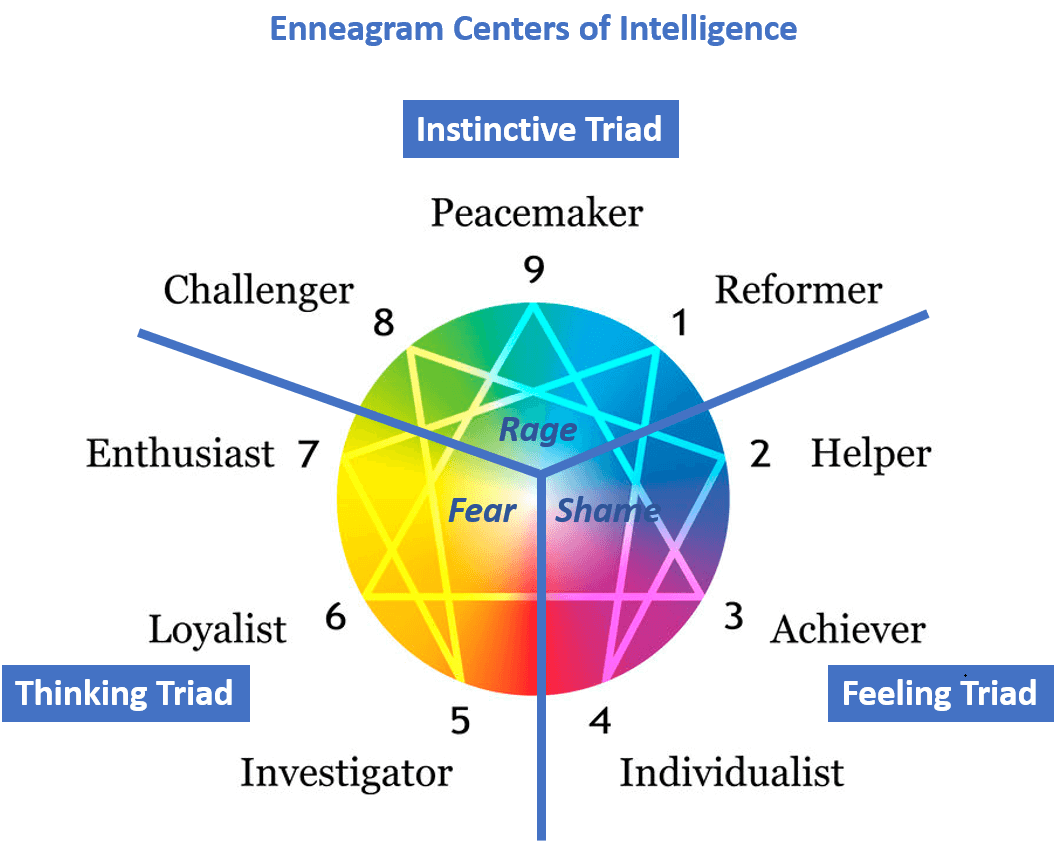Enneagram triads divide the 9 Enneagram types into 3 groups. Understanding your triad provides precious insights into your personality that you may not be aware of.
In the Enneagram structure, Triads, which divide the 9 Enneagram types into three different groups, play a significant role in an in-depth understanding of one's personality. Being aware of which Enneagram triad your personality type falls into gives you valuable insights into your underlying emotions, core motivations, decision-making style, and how you respond to stress. By understanding your triad, you, yourself, can enable you to identify areas for growth and development, improving relationships, your career, and your overall well-being.
The Enneagram triads are three groupings of three different personality types, including the Gut triad (Body types), the Feeling triad (Heart types), and the Thinking triad (Head types), each associated with a center of intelligence (the body or gut center, the heart center, the head, respectively). Exploring the Enneagram triad can lead to a more profound self-awareness and better understanding of others, which can nurture empathy, personal growth, harmonious relationships, and professional achievements.
Indeed, triads are a valuable beacon for self-discovery, personal development, and transformation, enabling individuals to embrace their strengths, address their weaknesses, and foster healthier relationships. Thanks to Enneagram triads, no matter what Enneatypes you are, it’s possible for you to make reasonable decisions and navigate life's obstacles with greater clarity.
It’s worth noting that the three Enneagram triads all come with distinct dynamics, characteristics, core motivations, controlling emotion, and struggles, with particular types within them sharing commonalities and differences simultaneously. Understanding what issues each triad has or the underlying feelings associated with each particular triad provides in-depth insights into different Enneatypes and how they interconnect.
Note: In fact, there are four major different triads: the harmonic triads, the Hornevian triads, the harmony triads, and most commonly, the center of intelligence triads. Here, we merely focus on the center of intelligence triads with three core centers: head, heart, and gut or body.
Here’s a detailed look at the three centers of intelligence triads, including the Gut triad (Body type), the Feeling triad (Heart type), and the Thinking triad (Head type), their deep insights, dominant emotions, motivations, and more.
The Gut Triad, aka instinctive triad, body triad, or anger triad, encompassing Enneagram Types 8, 9, and 1, is primarily focused on instinct and gut reactions. The triad and types belonging to it are often associated with a desire for control and autonomy, together with a deep sense of self-preservation. At the heart of this triad lies a shared focus on problems related to aggression, repression, control, and the pursuit of integrity.
Individuals with this triad often rely on their instincts and intuition to react to the world around them and make decisions. These people tend to be principled and decisive but can also be rigid, passive, and aggressive. They try to manage feelings of rage carried underneath their ego defenses.
However, the way each Enneagram type of this triad manages and expresses their inner rage is not the same. While Type 1, the Reformer, tends to repress rage, Type 8, the Challenger, tends to act out rage, but Type 9, the Peacemaker, tends to deny it.
More specifically, Eights externalizes anger and uses it as a source of energy and power. As for Nines, they internalize anger and repress it to maintain harmony and stability; on the other hand, Ones try to rationalize anger and channel their energy into striving for perfection and a sense of duty and morality.
In summary, the Gut triad's underlying feeling is anger or rage. This triad has issues with aggression and repression, while resistance and control of the environment are what it’s concerned with. Plus, individuals belonging to this Enneagram triad tend to seek control, autonomy, and a sense of self-preservation.
The Feeling Triad (also referred to as the Heart Triad) encompasses the Enneagram Types 2, 3, and 4, who rely on their feelings and emotions to navigate reality. It’s worth emphasizing that there’s a great deal of shame carried underneath their ego defenses. To overcome their underlying shame, these individuals often seek the feeling of being valuable by cultivating a positive self-image. At its core, the Enneagram Feeling Triad's traits revolve around love, shame, and the quest for personal identity. Individuals who have this triad are often warm, expressive, caring, people-pleasing, and creative; however, at the same time, they can also be moody, needy, and image-conscious. They tend to seek attention, recognition, love, and identity and be motivated by the need and want to be loved, valued, and unique.
As with the types belonging to The Enneagram Gut triad, those within the Feeling triad also feature a bunch of distinctions along with their commonalities. Type 2, the Helper, are warm-hearted individuals; they tend to externalize shame, try to earn love and approval and find fulfillment in helping and caring for others, seeking validation through their acts of kindness. In contrast, Type 3, the Achiever, internalizes shame and masks their emotional vulnerability by striving for recognition and success and avoiding failure and criticism. As for type 4, the Individualist, individuals with this Enneagram type are introverts and they tend to rationalize shame; they try to seek identity and meaning by being different and authentic.
In short, the Feeling triad's underlying feeling is "shame." It has issues with identity and hostility, while love of false self and self-image are what it’s concerned with. Plus, individuals belonging to this triad tend to seek attention.
The Thinking Triad (also known as the Head Triad) consists of individuals with Enneagram types 5, 6, and 7, who rely on their thinking and analytical and logical nature to navigate reality. People associated with the Thinking triad are often curious, analytical, and inventive though they can also be anxious, detached, and escapist. Those with this type of triad often seek knowledge, stability, security, and stimulation, while they tend to avoid ignorance, vulnerability, and pain. What motivates them is nothing but the need and want to be prepared, to be understood, and to be satisfied.
Fear is the dominant underlying feeling characterized by this triad. Similar to other triads, each particular type belonging to this triad possesses its distinct traits and ways to express and deal with fear. Type 5, the Investigator, externalizes fear and tries to gain mastery and expertise by acquiring information and skills. As for the people with Type 6, the Loyalists, they are very cautious and seek security through loyalty and careful consideration of potential risks. Type 7, the Enthusiast, seeks stimulation and novelty and tries to escape boredom and limitation by pursuing variety and excitement.
In a nutshell, the Thinking triad's underlying feeling is fear. It has issues with anxiety and insecurity, while beliefs and strategies are what it’s concerned with. Plus, individuals belonging to this triad tend to seek security.
As the Enneagram system’s subdivision, triads are a significant component of the entire Enneagram structure. Here’s a look at the Center of Intelligence Triads diagram so that it’ll be much easier for you to identify which Enneagram types belong to the Body Center (Instinctive Triad), Heart Center (Feeling Triad), and Head Center (Thinking Triad).

As you can see in the above visual representation of the Enneagram system, there’s a Y inside the circle, dividing it into 03 different wide triangles, which are exactly the triads. The top triangle represents the Instinct triad, or the Body or Gut Center, composed of the 1-8-9 types. The right one is the Feeling triad, including 2-3-4 types that represent the Heart Center of the Heart type in the Enneagram result, while the Thinking triad, or the Head center, is on the left, featuring the 5-6-7 types.
In addition, you can also find the underlying feelings linked with each triad in this Triads diagram, with rage, shame, and fear being core emotions connected to the Body, Heart, and Head triads, respectively. If you are new to Enneagram triads, this diagram is super helpful. It gives you a clearer direction to understand your Enneagram test results after taking our test; this way, you’ll never get lost in tons of information related to Enneagram and better understand your Enneagram results.

Enneagram triads offer insightful and practical applications in various areas of life, especially speaking of personal growth and enhanced relationships.
By identifying and understanding the triad you belong to, it’s totally possible for you to gain deeper insights into your motivations, underlying feelings, behaviors, communication style, and emotional and thinking patterns that you may not have been aware of. This self-awareness can guide you in your journey of personal growth. At the same time, you can move towards integration and a state of balance and fulfillment by addressing your triad's challenges.
Understanding the Enneagram triads of others and their different thinking and emotional patterns will help enhance your ability to communicate effectively as well as let you deeply appreciate their unique perspectives. This way, you can tailor your communication style accordingly to better connect with others. For example, if you communicate or collaborate with a Type Five (of the Thinking Triad), you may need to provide them with more data and information to support your idea, argument, or proposal.
Enneagram triads also give you in-depth insights into the root causes of conflict within yourself and with other people. Thanks to those precious insights, you’ll approach disagreements with empathy and understanding, foster harmonious relationships, and find more balance within yourself.
Want to figure out what enneagram triad you belong to? If so, take our Enneagram test now! As soon as you finish the test by answering 144 questions, our system will show you your full Enneagram report, including a detailed analysis of your Enneagram triad and Enneagram type.
Summary: Along with enneagram types, enneagram triads are a significant element of the whole Enneagram structure. In essence, Enneagram triads serve as a valuable tool for self-discovery, personal growth, and fostering better relationships, empowering individuals to embrace their strengths, address their weaknesses, and cultivate a deeper understanding of themselves and others